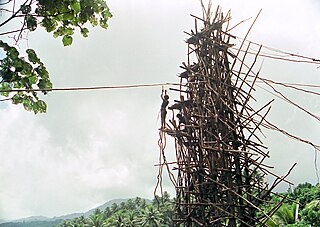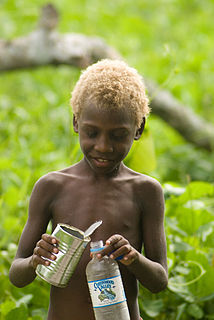 W
WThis article presents an overview of the culture of Vanuatu.
 W
WKava or kava kava is a crop of the Pacific Islands. The name kava is from Tongan and Marquesan, meaning 'bitter'; other names for kava include ʻawa (Hawaiʻi), ʻava (Samoa), yaqona or yagona (Fiji), sakau (Pohnpei), seka (Kosrae), and malok or malogu. Kava is consumed for its sedating effects throughout the Pacific Ocean cultures of Polynesia, including Hawaii, Vanuatu, Melanesia, and some parts of Micronesia, such as Palau. To a lesser extent, it is consumed in nations where it is exported as a herbal medicine.
 W
WLand diving is a ritual performed by the men of the southern part of Pentecost Island, Vanuatu. The precursor to bungee jumping, men jump off wooden towers around 20 to 30 meters high, with two tree vines wrapped around the ankles. Land diving is done by tying vines to each ankle. The tradition has developed into a tourist attraction. According to the Guinness World Records, the g-force experienced by those at their lowest point in the dive is the greatest experienced in the non-industrialized world by humans.
 W
WThe Livatu is a unit used by the Turaga indigenous movement and the Tangbunia Bank in Vanuatu to reckon the worth of items of traditional currency such as pigs and textiles. One livatu is equivalent to one fully curved boar's tusk, a symbolic item of value in Vanuatu culture. Long dyed mats, a less valuable item of exchange, are worth up to a half a livatu.
 W
WA namba is a traditional penis sheath from Vanuatu. Nambas are wrapped around the penis of the wearer, sometimes as their only clothing. Two tribes on Malakula, the Big Nambas and the Smol (Small) Nambas, are named for the size of their nambas.
 W
WNi-Vanuatu is a large group of closely related Melanesian ethnic groups native to the island country of Vanuatu. As such, Ni-Vanuatu are a mixed ethnolinguistic group with a shared ethnogenesis that speak a multitude of languages. It is more frequently used than the demonym Vanuatuan, which is regarded as incorrect by some authors and style guides.
 W
WSand drawing is a ni-Vanuatu artistic and ritual tradition and practice, recognised by UNESCO as a Masterpiece of the Oral and Intangible Heritage of Humanity.